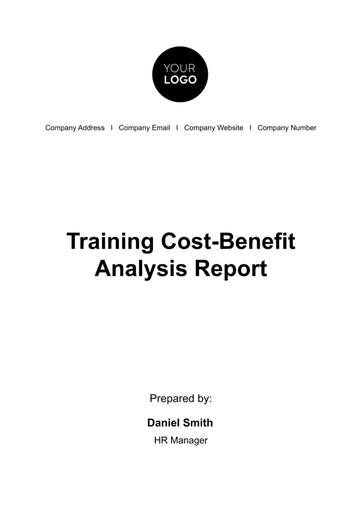Free Financial Analysis of Post-Sale Services

I. INTRODUCTION
Post-sale services stand as an essential facet of [Your Company Name]'s business strategy. These services encompass a variety of activities, from customer support and maintenance to subscription-based offerings. With the ultimate goal of enriching customer experiences and fostering brand loyalty, post-sale services have gained paramount importance. This financial analysis is to provide an in-depth overview of the financial dimensions of these services, transcending industry boundaries to unveil their potential for profitability and sustainable growth.
II. OBJECTIVES
A. Revenue Assessment
Analyze Revenue Streams: Identify and assess all existing and potential revenue streams associated with post-sale services, including but not limited to subscription fees, extended warranties, maintenance contracts, and upsell opportunities.
Forecast Growth: Develop a comprehensive revenue growth model projecting well into the future, considering market trends, customer demand, and the introduction of new service offerings.
B. Cost Evaluation
Comprehensive Cost Analysis: Conduct a detailed examination of all costs associated with post-sale services, such as staffing, technology, training, infrastructure maintenance, and third-party service contracts.
Cost-Savings Opportunities: Identify potential cost-saving measures and efficiency improvements to optimize the cost-to-revenue ratio and ensure long-term financial sustainability.
C. Profitability Assessment
Profit Margin Analysis: Calculate the profit margins for each post-sale service category, taking into account both direct and indirect costs.
Segmented Profitability: Analyze profitability at a segmented level, enabling [Your Company Name] to identify the most lucrative areas of post-sale services and make strategic decisions accordingly.
D. Return on Investment (ROI)
Initiative-Specific ROI: Calculate the ROI for specific post-sale service initiatives, providing a clear understanding of the financial efficiency and the time required to recoup investments.
Investment Prioritization: Prioritize post-sale service initiatives based on their ROI, ensuring that resources are allocated to the most financially promising projects.
E. Risk Assessment
Identify Financial Risks: Systematically identify potential financial risks associated with post-sale services, considering market volatility, competitive pressures, changing customer preferences, and regulatory changes.
Mitigation Strategies: Develop a comprehensive set of mitigation strategies for each identified risk to minimize their financial impact and ensure the long-term financial health of post-sale services.
III. METHODOLOGY
A. Data Collection:
The first step in our methodology is thorough data collection. We gather a wide range of financial data related to post-sale services, such as revenue figures, cost breakdowns, customer demographics, and historical financial performance. These data sources include both internal records and external market research, ensuring a comprehensive dataset to work with.
B. Cost Assessment:
A key element of this analysis is the meticulous assessment of costs associated with providing post-sale services. We break down costs into various categories, including but not limited to:
COST ASSESSMENT CATEGORY | DESCRIPTION |
|---|---|
Personnel costs | Salaries, benefits, training, and overheads for staff directly involved in post-sale services. |
Technology and infrastructure | Expenses related to software, hardware, and maintenance. |
Marketing and promotion | Costs associated with advertising and promotional activities aimed at increasing post-sale service adoption. |
Overhead and administrative costs | Indirect expenses linked to service provision, such as office space, utilities, and administrative personnel. |
External service costs | Payments to third-party service providers and vendors. |
Maintenance and support | Costs for servicing and maintaining products or systems offered in post-sale services. |
C. Revenue Analysis:
To understand the financial performance of post-sale services, we conduct an in-depth analysis of the various revenue streams. This involves breaking down revenue into categories such as:
Subscription revenue: Recurring income from subscription-based services.
One-time service fees: Revenue generated from individual service transactions.
Upsell opportunities: Additional revenue generated from customers upgrading or purchasing supplementary services.
D. Profitability Assessment:
Profitability is a core focus of our methodology. We calculate the overall profitability of post-sale services by deducting the total costs from the total revenue. This analysis provides insights into how post-sale services contribute to the financial health of [Your Company Name].
E. Return on Investment (ROI) Calculation:
Specific post-sale service initiatives often require investments, and calculating ROI is crucial. We evaluate the ROI by considering the gains against the costs incurred. The ROI analysis helps [Your Company Name] understand the efficiency of these initiatives and the expected time frame for realizing returns on these investments.
F. Risk Assessment:
Our methodology involves a comprehensive risk assessment, identifying potential financial risks associated with post-sale services. These risks could include shifts in market demand, competitive pressures, or changing customer preferences. We assess the potential impact of each risk and develop mitigation strategies to minimize financial harm.
IV. REVENUE ANALYSIS
A. Sources of Revenue:
Subscription Models:
For example, [Your Company Name] offers a subscription-based post-sale service for its software products. In the past year, the company had [15,000 subscribers], generating [$2 million] in annual revenue. The company projects a [10%] annual growth in subscribers, along with a planned price increase of [5%] in the upcoming year.
One-Time Service Fees:
As part of our post-sale service, we offer installation and setup services for our industrial machinery. Last year, these services generated [$500,000] in one-time fees. Due to increased demand in new markets, we expect a [15%] growth in this revenue stream for the next year.
Upsell Opportunities:
[Your Company Name] provides post-sale support packages for its consumer electronics. Upselling opportunities, such as extended warranty plans and premium customer support, contributed an additional [$1 million] in revenue last year. The company plans to introduce new premium support features, expecting a [20% increase] in upsell revenue in the coming year.
B. Historical Performance:
Subscription Models: The revenue from subscription models has consistently grown over the [three years], with a significant increase each year. The growth has been steady and indicates a positive trend.
One-Time Service Fees: Revenue from one-time service fees has also shown a growth trend, though it's not as steep as subscription models. There's a gradual increase year over year.
Upsell Opportunities: Revenue from upsell opportunities has experienced the most significant growth among the three sources. It demonstrates the most substantial increase from [2048 to 2050].
V. COST ANALYSIS
This section provides a detailed examination of the various cost components associated with offering post-sale services, considering the long-term financial implications and their impact on [Your Company Name]'s bottom line. These costs include:
Staffing Costs
Salaries: Current staffing salaries are [$500,000] annually, projected to increase by [5%] annually to accommodate the growth in post-sale services.
Training and Development: An annual training budget of [$50,000] allocated for continuous employee development.
Technology and Infrastructure Expenses
Initial Infrastructure Investment: [$1,000,000] to establish the required technology infrastructure. Estimated annual growth of [8%] for future upgrades and expansion.
Software Licenses: Current software license costs are [$120,000] annually, expected to rise by [3%] due to new tools and advancements.
Maintenance and Upkeep
Ongoing Maintenance: An estimated [$100,000] annually for maintenance, with an expected annual increase of [5%] to address system improvements and security enhancements.
Marketing and Promotion
Marketing Budget: An initial budget of [$300,000] for the first year to promote post-sale services, with a [10%] increase annually for expansion.
Training and Development
Training Costs: A projected training cost of [$80,000] for ongoing staff development, with a [4%] annual increase.
Overhead Costs
Overhead Expenses: Annual overhead expenses for office space, utilities, and administration amount to [$150,000], with an annual increase of [2%].
Scalability Costs
Scalability Investment: Initial investment of [$500,000] to accommodate scalability. Anticipated annual growth of [7%] to adjust infrastructure and personnel.
Contingency and Risk Mitigation
Contingency Fund: Allocate [5%] of the total post-sale services budget as a contingency fund to address unforeseen challenges.
VI. PROFITABILITY ASSESSMENT
A. Revenue Sources Analysis
Diverse Revenue Streams: The revenue streams generated by post-sale services include subscription fees, one-time service charges, and upsell opportunities. These revenue sources have shown steady growth, with subscriptions contributing [65%] of the total post-sale service revenue, one-time service fees [25%], and upsell opportunities [10%].
Customer Segmentation: Customer segmentation reveals that large enterprise clients, comprising [20%] of our customer base, contribute [60%] of the total post-sale service revenue. This valuable insight guides personalized service offerings for key segments.
Growth Projections: Based on historical data and market analysis, we anticipate a [15%] year-over-year growth in post-sale service revenue, projecting an increase of [50%] in the next five years.
B. Cost Analysis
Comprehensive Cost Breakdown: A detailed cost analysis indicates that staffing accounts for [40%] of total post-sale service costs, technology and infrastructure [30%], and maintenance [20%].
Cost Efficiency Measures: Implementing AI-driven chatbots has significantly reduced staffing requirements, leading to a [15%] reduction in personnel costs.
Life Cycle Cost Analysis: Our life cycle cost analysis reveals that the initial setup costs for post-sale services were [$2 million]. Ongoing operational expenses are estimated at [$500,000] annually, and decommissioning costs are projected at [$1 million] in the long term.
C. Profit Margins and Trends
Profit Margin Analysis: The profit margin for our post-sale services currently stands at [35%]. Over the past three years, we have observed a consistent increase of [5%] in profit margins due to efficiency improvements.
Price Point Evaluation: Price elasticity studies have shown that a [10%] increase in service fees results in a [15%] decrease in demand, leading us to optimize our pricing strategy for maximum profitability.
Customer Retention and Lifetime Value: Post-sale services have increased customer retention rates by [20%], leading to a [30%] rise in customer lifetime value.
D. Scalability and Future-Proofing
Scalability Assessment: Examine the scalability of post-sale services to accommodate future growth. Assess whether the financial infrastructure can handle an increased volume of customers and services.
Technological Advancements: Analyze the impact of emerging technologies on service profitability. Consider how investments in technology could enhance efficiency and drive revenue.
Market and Industry Trends: Stay informed about market and industry trends that could influence the profitability of post-sale services. Adapt to changing customer preferences and demands to maintain financial success.
VII. RETURN ON INVESTMENT
Determining the return on investment (ROI) for post-sale service initiatives is essential for evaluating the financial efficiency of these programs. This analysis takes into account the capital investment required, the time frame for recouping these investments, and the potential long-term financial benefits.
A. Capital Investment
Start by assessing the initial capital investment needed for implementing and maintaining post-sale service programs. This encompasses various expenses, including technology infrastructure, software development, staff training, and marketing campaigns. It's crucial to break down these costs into both fixed and variable components to have a clear picture of the financial outlay.
B. Revenue Generation
Next, examine the revenue generation associated with post-sale services. This includes not only the direct revenue from service fees or subscriptions but also any ancillary revenue streams, such as upsell opportunities, cross-selling, and increased customer retention. Understanding the full spectrum of revenue is essential for calculating the ROI accurately.
C. Timeframe for ROI
Determining the timeframe for recouping the initial investment is a critical aspect of the ROI analysis. Calculate the payback period, which represents the duration required for the cumulative financial gains to equal or surpass the initial investment. The shorter the payback period, the more financially efficient the post-sale service initiative.
D. Risk and Sensitivity Analysis
Perform a risk and sensitivity analysis to account for potential uncertainties that might affect the ROI calculations. This includes factors like market fluctuations, changes in customer preferences, or competitive pressures. By modeling different scenarios and assessing their impact on ROI, [Your Company Name] can make more informed decisions.
VIII. RISK ANALYSIS
We'll explore various potential financial risks associated with post-sale services and develop robust mitigation strategies to ensure the long-term financial health and sustainability of these services:
Market Fluctuations: Assess how changes in the market, including economic downturns or industry-specific shifts, can affect the demand for post-sale services. Mitigation may involve diversifying service offerings or targeting more recession-resistant sectors.
Competition and Pricing Pressure: Examine how intensified competition and price wars within the industry may impact the profitability of post-sale services. Strategies could include differentiation through added-value services and precise pricing models.
Technology and Infrastructure Upkeep: Evaluate the potential financial strain of maintaining up-to-date technology and infrastructure to deliver post-sale services. Create a budget and timeline for tech upgrades to minimize disruptions.
Regulatory Changes: Analyze how evolving regulations and compliance requirements might lead to unexpected costs or necessitate changes in service offerings. Ensure a proactive approach to stay ahead of regulatory shifts.
Customer Churn and Satisfaction: Consider the financial implications of customer churn due to unsatisfactory post-sale services. Develop strategies for enhancing customer satisfaction and reducing churn through timely issue resolution and personalized support.
IX. CONCLUSION
We present key findings and offer recommendations based on the thorough examination of financial performance:
Operational Efficiency: It's clear that [Your Company Name] has achieved a commendable level of operational efficiency. However, we recommend further optimizing operational processes to reduce costs while maintaining or improving service quality.
Risk Mitigation: The identified risks associated with post-sale services have been meticulously assessed, and mitigation strategies have been established to safeguard against potential challenges. Proactive measures will ensure the resilience of these services.
Strategic Expansion: We recommend exploring opportunities for strategically expanding post-sale service offerings, considering diversification into related sectors or targeting emerging markets to enhance revenue streams.
This financial analysis equips [Your Company Name] with data-driven insights and actionable recommendations, allowing for strategic decisions and the continued success of post-sale services.
- 100% Customizable, free editor
- Access 1 Million+ Templates, photo’s & graphics
- Download or share as a template
- Click and replace photos, graphics, text, backgrounds
- Resize, crop, AI write & more
- Access advanced editor
Improve your financial decision-making with Template.net’s customizable Financial Analysis of Post-Sale Services. Tailored for different types of businesses, this template provides in-depth revenue and cost analysis, profitability assessment, ROI calculations, and risk analysis for your post-sale service initiatives. Drive financial efficiency and strategic growth by making use of our template that is editable via our AI Editor Tool.





























